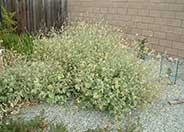
Common name:Indian Mallow
Botanical name:Abutilon palmeri
Herbaceous shrub with velvety, heart-shaped leaves. Grows quickly to 4'-5' tall and 3' wide. Good for subtropical effect. Plant it next to a patio to enjoy soft texture. Takes full sun or partial shade. Takes reflected heat. May freeze in colder climates. Cup-shaped, apricot-colored blooms on and off during warm months. Arizona Native as well as in low Sonoran Desert in Southern California.
Maintenance Tips
Abutilon palmeri is a fast-growing, California native shrub that has a very dense, but irregular, growth habit. It can get 4-5' tall in one growing season but can continue to grow up to 8' tall and wide if left alone. The majority of the maintenance on this plant is pruning to shape it and keep it in the desired space. One of the best ways to keep the maintenance as low as possible is to give it plenty of room to reach its mature size. If other plants are crowing it out, transplant those other plants further away. This plant can thrive in both full sun and partial shade, but it does not like a wet root system. If it is planted in a shady area, make sure the soil isn’t collecting or retaining moisture. Also, shady areas will result in a taller, rangy plant, so it may require some pruning to encourage lower growth.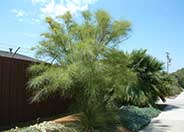
Common name:Mexican Palo Verde, Jerusalem Thorn
Botanical name:Parkinsonia aculeata
The Mexican Palo Verde has prickly stems. This tree is very fast growing with sparse foliage and very long narrow leaves. Yellow flowers with orange red throats bloom sporadically. It is very messy, thorny, weedy and short-lived. This tree is usually found on limestone soils in areas with moisture but is strongly drought tolerant. It can withstand saline conditions. It can be cold or drought deciduous. It is beautiful in form being light and airy looking, with green bark.
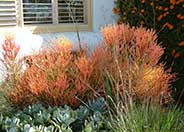
Common name:Sticks on Fire Pencil Tree
Botanical name:Euphorbia tirucalli 'Sticks on Fire'
In frost free areas, Euphorbia can become a 30' tree but in colder areas, it is often knocked back by frost. It can be single or multiple trunked. It has green cylindrical branches that are about the diameter of a pencil. Leaves are not usually present. Some people are allergic to the sap. It is tolerant of salt, full sun, part shade and quite drought resistant. It is a great accent plant for a container. This form has yellow or orange branches if in full sun.
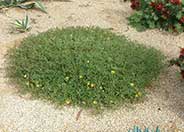
Common name:Sundrops
Botanical name:Calylophus hartwegii
This low-growing perennial grows 1' tall and 3' tall; it has woody stems with bright green leaves. It produces large, lemon yellow flowers that are up to 4" across and bloom spring through summer and possibly through fall, depending on weather conditions.
Maintenance Tips
Calylophus hartwegii is a soft-textured, low-growing perennial with bright yellow flowers. It only grows 12" tall and up to 3' wide. It is very fast growing in the late winter and early spring, and then it is covered with flowers from mid-spring until fall if the weather is ideal. In the fall, when the days start to get shorter and the rains begin, this plant can decline. The root system will stay intact, but the flowering stops, and the foliage will completely die back. This plant benefits from hard pruning, taking the foliage, and branching almost down to the ground. Don't expect any new growth to emerge until the days start to get longer and warm up. The foliage will start to emerge, and the plant's quick growth and blooming cycle will return.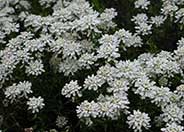
Common name:Evergreen Candytuft
Botanical name:Iberis sempervirens
This Evergreen Candytuft is a compact plant that grows 12"-18" tall. Its leaves are dark green in color; in the early spring, it exhibits clusters of pure white flowers that are borne at branch ends.
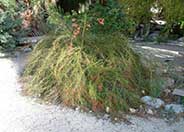
Common name:Coral Fountain, Firecracker Plant
Botanical name:Russelia equisetiformis
This heavy blooming shrub is from tropical Mexico. Coral Fountain can reach a mature size of about 5' tall and wide in frost-free climates. In colder climates, foliage will die back at freezing, but the plants will survive all but a hard frost. This is an excellent plant for containers, so plants can be moved to a sheltered location in winter for frost areas.
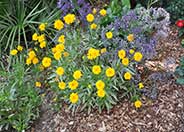
Common name:Sunburst Coreopsis
Botanical name:Coreopsis grandiflora
The 'Double Sunburst' is a wonderful cultivar and a showy, Southeast U.S. native. Golden yellow, double flowers on 2' bushy plants bloom during spring in full sun and average to dry soils. It makes for good cut flowers, and pruning keeps the plants abundant with blooms.
Maintenance Tips
Coreopsis grandiflora is a clumping evergreen perennial with very showy flowers that emerge in spring. This is a very drought-tolerant plant that will look and perform its best in full sun and well-drained soil. It grows 2-3’ tall and 1-2’ wide, so can be used in just about any space in any sized garden without having to prune to maintain the size. This plant rarely has any pest problems, but it is susceptible to some fungal infections, usually brought on by wet conditions in poorly drained soils. This plant will benefit from some fertilizer to keep it looking and performing its best. Deadheading is the best way to keep the plant blooming throughout the year. As soon as the flowers fade and seeding begins, the look and the health of the plant can decline. Once this happens, the plant can be cut back hard to invigorate and encourage new growth.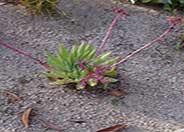
Common name:Dudleya
Botanical name:Dudleya brittonii
Dudleya brittonii is a succulent with a large open rosette of waxy leaves. This plant will grow 15" high and produces pale yellow flowers on 35" stems.
Maintenance Tips
Dudleya brittonii is a dramatic, rosette-shaped succulent also known as Giant Chalk Dudleya. The plant stays low to the ground, but the individual rosettes grow 12 - 18" wide. This is one of the most drought-tolerant plants you can have in your garden. It can survive with almost no maintenance, pruning, or even supplemental water once it is established. To keep it looking and performing its best, do not plant it in lower spots in the garden or anywhere that moisture collects. A rock garden environment would be perfect to keep this plant looking and performing its best. This plant can take full sun along the coast but would do better with some light shade when planted inland. As it matures, the older leaves will collect under the large rosette, and these older leaves can be removed occasionally to keep the plant looking tidy.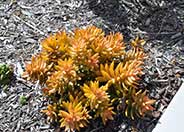
Common name:Orange Sedum
Botanical name:Sedum nussbaumeranian
This succulent perennial will grow best in a wall pot or hanging basket due to its long stems. It has light, gray green leaves that grow over one another to give off a "braided" look. The flowers are pink to deep red and bloom in spring and summer.
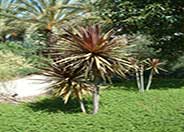
Common name:Red Star Cordyline
Botanical name:Cordyline 'Red Star'
The 'Red Star' cultivar is an evergreen shrub that grows 12' to 30' tall and 10' to 15' wide with sword-like leaves with a reddish color. It likes full sun, and is very tolerant of heat and drought. It will live in any type of soil that is well drained. Cut back to develop multiple trunks.
Designer: Susan Trindle
Photographer: GardenSoft
Incorporate compost 6" into your soil to retain water, reduce compaction, feed earthworms, and provide valuable nutrients to your plants.
Be sure to fix all leaks promptly no matter how small they may seem.
Attract, or buy beneficial insects such as ladybugs and lacewings to control pest outbreaks in your garden.